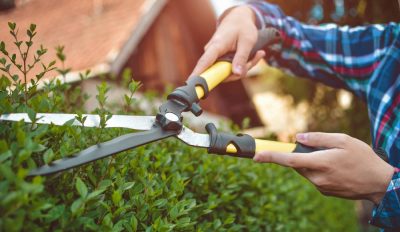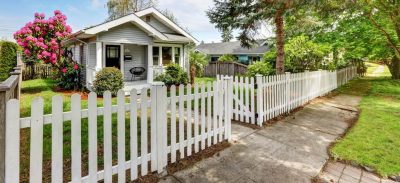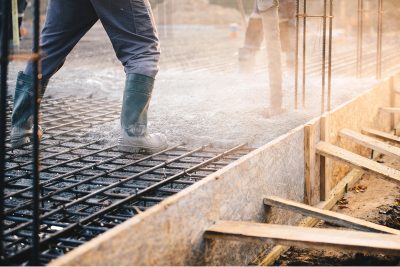- Oneflare /
- Cost Guides /
- Pavers

How much does Paving cost?
$20 - $60 per m2
How Much Does Paving Cost Per Square Metre?
Outdoor paving instantly boosts your outdoor space. It’s a simple upgrade, but it can be physically demanding to do on your own. You should expect to pay about $30 to $60 or more per square metre for paving. Specialised paving projects that include borders will incur higher costs and materials.
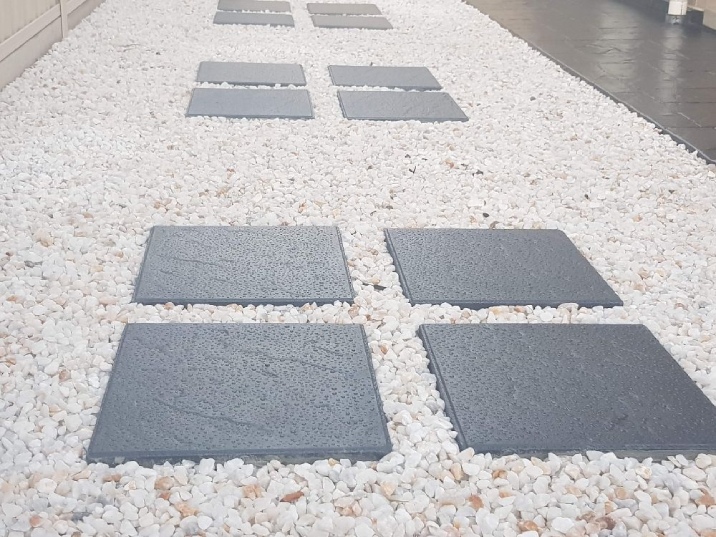
Grey stepping stone pavers on white pebbles. | Source: Rewind Landscapers
How Much Do Pavers Cost?
The average price for mid-range pavers in Australia is about $3. Depending on your choice of material, pavers can cost as high as $35 and as low as $1 each.
Factors Impacting the Cost of Paving
When it comes to selecting pavers for your home improvement projects, there are many factors to consider that impact the overall cost.
Materials
The depth of base materials, which is the foundation that provides stability and longevity for the pavers.
Types of pavers
Paving materials can vary widely, with some being very expensive while others are more affordable. For instance, rubber and vinyl/plastic are in the more affordable range at $5, whilst flagstone, brick and marle can cost up to $100+ per m2.
Labour costs
Paving labour costs in your local area can also vary. For example, the amount of preparation required for sloping and levelling of the construction site can undoubtedly impact the total cost.
Therefore, it’s wise to obtain at least two to three estimates to make your decision.
Complexity and size of the project
How elaborate your design is will determine the time needed. Since the paving cost is based per square metre for both materials and labour, the size and complexity will directly affect the price.
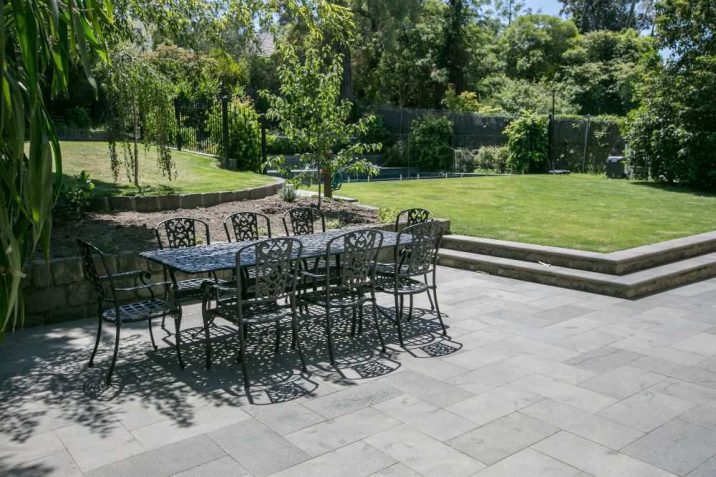
Large backyard with a paved area. | Source: Moxeys Landscapes & Gardens
Price Estimates for Different Types of Paving Projects
There is a wide range of paving materials available for different types of paver projects. They can all be used for a variety of applications such as outdoor landscaping, driveways, pathways, patios, and pool surrounds.
Here are some average estimates for residential paving costs that include the labour and the most common types of pavers utilised in Australia for residential home improvement projects:
Concrete ($45 to $60)
Concrete pavers cost makes them a popular option. Many companies offer a wide selection on their concrete pavers price list. However, concrete can show stains and cracks with extreme changes in temperature.
Brick ($70 to $90)
Brick is a popular choice for a classic look. It is also long-lasting. Brick pavers cost also makes it a popular choice. One of the disadvantages is that it can heave or move with the weather, which can cause it to require levelling.
Limestone ($40 to $90)
Limestone gives you a beautiful, natural look. You can choose to cut limestone or natural stones with decorative gravel in between. Limestone paving prices make this an affordable, durable choice, but matching colours can be a challenge.
Quartzite ($40 to $75)
Quartzite is a type of quartz sandstone. It has a shimmer that catches the light. One of the disadvantages of this type of paver is that sandstone tends to erode or weather over time, giving it an aged look.
Flagstone ($75 to $100)
Flagstone comes in beautiful blues, browns, moss green, grey, and sand. However, if you ever want to add to the project, or need to replace a few stones, you might not be able to get the exact colour in the future.
Travertine ($75 to $100)
Travertine has a honed and polished surface. It can be slick when wet and tends to be hot underfoot when the weather is warm. The cost of installing travertine pavers can be higher than other materials.
Granite ($75 to $100)
Granite is a durable material and comes in a wide range of colours. It is a heavy stone, but granite pavers price is its disadvantage if you are on a budget.
It’s also important to remember that the cost of the paving foundation is separate from the cost of materials and labour unless your contractor offers a package price that includes the base materials.
Base materials consisting of crushed rock can cost, on average, between $1,500 and $1,800 for a 50-square-metre for a site with minimal preparation and easy access. If you want concrete poured, the same 50 square metre area can cost between $2,300 and $2,800.
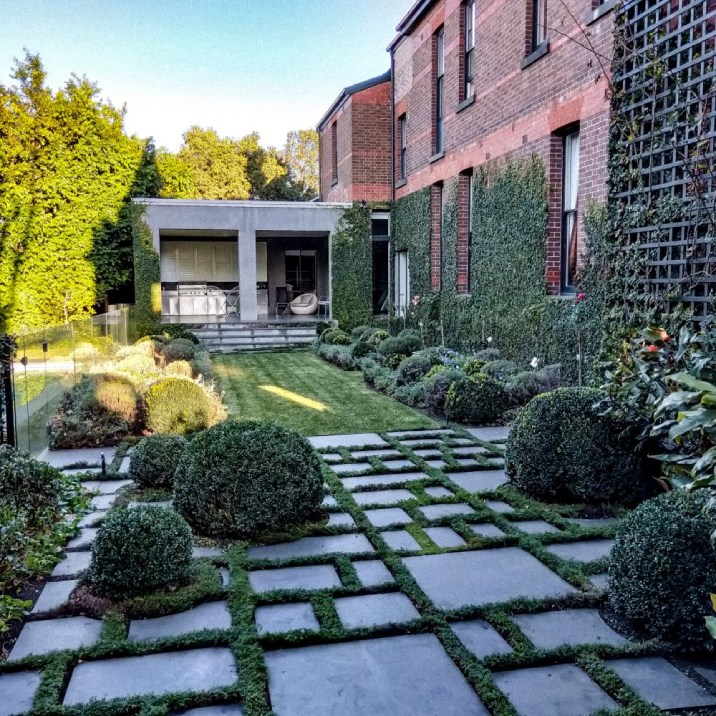
Paved area in a large backyard. | Source: Must Have Maintenance
The shape and size of the paver also affect the cost–larger square pavers are easier and faster to lay than small or intricate pavers. More cuts required for border pavers also increase project costs.
For example, a concrete driveway paving cost for level driveways can start from $65 per square metre, while the same driveway, if sloped, can cost about $75 per square metre. Pool pavers that include borders and slip-resistant materials can cost between $85 and $100 per square metre or more.
Does the Cost of Pavers Differ Based on Location?
The cost of paving contractors does vary from state to state and city to city. For example, the price for paving installations in western cities such as Perth is a lot lower for the same job than in eastern cities such as Melbourne, Sydney, Brisbane or Adelaide.
| State | Average Paving Cost Per M2 |
| Victoria | $70 |
| New South Wales | $60 |
| Queensland | $45 |
| Western Australia | $30 |
| South Australia | $35 |
Additionally, besides the project’s overall cost, it’s always a good idea to consider how qualified the paving contractor is before you hire them, the distance their business is away from your location, and their warranty policy on installations.
Tips on How to Create an Accurate Estimate
Before you start your paving project, it’s a good idea to create an accurate estimate to stay within your budget.
Tip #1: You can calculate square metres by measuring the length and the width of the area where you want the pavers to go. Then, multiply the two numbers together, and this will provide how many square metres you have
Tip #2: You should consider the prep work and whether you need a level or sloped surface for your pavers
Tip #3: Remember that the base is a separate price aside from the paving cost for materials and labour
Tip #4: If you have plants or shrubs that need to be removed, you should also factor in removal costs for soil stripping, plant uprooting, and bins
Tip #5: Once you know how many square metres your project is, you can decide on the types of pavers that work within your budget. This is also a good time to determine whether you want only border pavers.
How to Hire a Paver
When you’re looking for paver contractors, get estimates from the ones who are the closest to your area. Travel time and expenses can add to your overall cost if you select a paver contractor who operates far away. Here are some tips:
- Ask them if they have a valid insurance policy and if they’re licensed to work on your project
- Find out if they provide free onsite inspections
- Make sure the quotes include all of the materials, such as the base and total cost
- Ask them for references and give them a call.
Licensing requirements in Australia
Depending on where you live in Australia; licensing varies from state to state.
| State | Licencing Requirements |
| Victoria | Builder Licence |
| Queensland | Structural Landscaping Licence |
| Western Australia | No licence required unless the project exceeds $20,000 |
| New South Wales | Concreting Licence for paving and concrete |
Your paving contractor should be able to answer your questions on licensing, and you can always call your local municipality to verify their information.
Tips on How to Save Money When Hiring a Paver
Laying pavers can get expensive, so it’s best to prepare and know how you can stick to your budget.
Tip #1: Organise any other contractors first to avoid delays. For example, if you need to remove plants, start the prep work yourself or hire a gardener.
Tip #2: To avoid future paver repair costs for driveways, it is essential to install a solid foundation to ensure that it doesn’t move or warp from the weight of your vehicles.
Tip #3: Pool surrounds should also utilise pavers that are slip-resistant to ensure safety.
Tip #4: Pick a level area. Workaround existing plants, shrubs, and trees.
Tip #5: Construct the site close to the house.
Tip #6: Choose inexpensive pavers and buy your pavers in the offseason.
Get started with your paving project
Pavers designed for patios can extend your outdoor living space and be a functional decorative element that ties all your paving projects together. It’s ideal to leave this gruelling task to paving experts to transform your outdoor areas into a space you can enjoy for years.
* The cost data is based on Oneflare and third-party sources
Real Oneflare Customer Quotes
Mary's Paver Job
Job type
Paving ideas
Type of building
Home
Area of home
Backyard with 2 car garages
$20inc. gst
Quoted by Brick Pavers Perth
Jeff's Paver Job
Job type
Paver removal and new base
Paver repairs
Additional pavers to replace broken pavers
Type of building
Nursing home
$1000inc. gst
Quoted by Northern Suburbs Retaining Walls
Richard's Paver Job
Job type
Surface levelling and paving
Design
Herringbone pattern
Shape of area
Rectangle
$300inc. gst
Quoted by Perth Southern Landscapes
